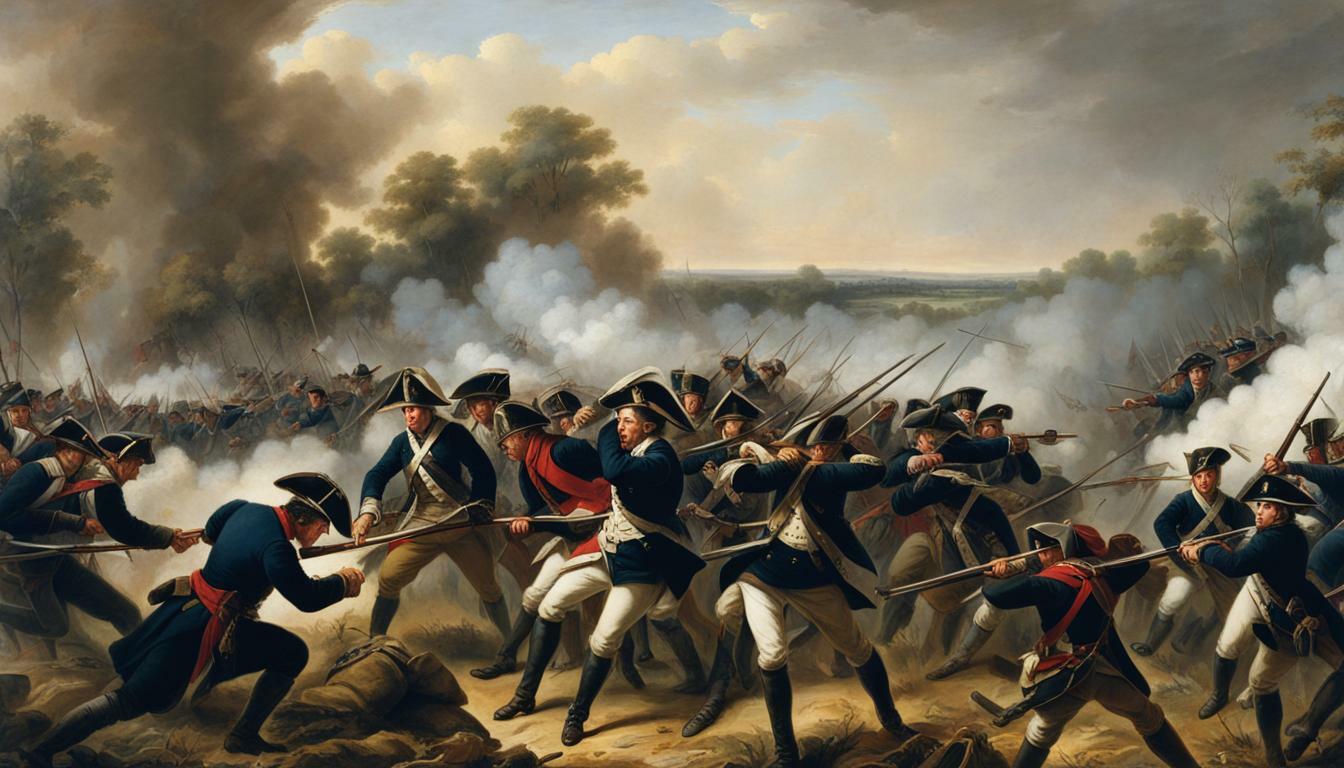The Battle of White Plains was a pivotal event during the American Revolutionary War, fought on October 28, 1776. After retreating from New York City, George Washington’s Continental Army established a position in the village of White Plains. However, they failed to gain control of the high ground. British General William Howe’s troops drove Washington’s troops from a hill near the village, leading to Washington ordering a retreat farther north. The battle resulted in a British victory, and Washington’s army was chased across New Jersey and into Pennsylvania. This eventually led to the Battle of Trenton on December 26, where Washington surprised Hessian troops.
- The Battle of White Plains took place on October 28, 1776, during the American Revolutionary War.
- George Washington’s Continental Army retreated from New York City and established a position in White Plains.
- The American forces failed to gain control of the high ground, resulting in a British victory.
- Washington ordered a retreat farther north, and the battle had significant consequences for the Revolutionary War.
- The Battle of White Plains ultimately led to the Battle of Trenton, where Washington surprised Hessian troops.
Background of the American Revolution
The American Revolution was a struggle for independence from British rule that took place between 1775 and 1783. It was a pivotal moment in history that shaped the formation of the United States of America. The revolution was spurred by a variety of factors, including political, economic, and ideological tensions between the American colonies and Great Britain.
One of the main catalysts for the revolution was the imposition of taxes on the colonists by the British government. This included acts such as the Stamp Act and the Townshend Act, which were met with widespread opposition and protests. The colonists believed that they were being unfairly taxed without representation in the British Parliament, leading to the famous slogan, “No taxation without representation.”
The American Revolution also had deep roots in Enlightenment ideals of liberty, equality, and individual rights. Influential thinkers such as Thomas Paine and John Locke espoused these ideas, which resonated with the colonists and fueled their desire for self-governance. The revolutionaries sought to create a society based on these principles, free from the perceived tyranny of British rule.
Key Events of the Revolutionary War
- The Boston Tea Party: In 1773, colonists protested British tea taxes by throwing crates of tea into the Boston Harbor.
- The Battles of Lexington and Concord: In April 1775, the first shots of the revolution were fired, marking the beginning of armed conflict between the colonies and the British.
- The Declaration of Independence: On July 4, 1776, the Continental Congress adopted the Declaration of Independence, officially announcing the colonies’ break from Britain and their intention to form a new nation.
- The Battle of Saratoga: Fought in 1777, this pivotal battle resulted in a significant American victory and convinced France to formally ally with the colonies against Britain.
- The Siege of Yorktown: In 1781, American and French forces surrounded British General Cornwallis at Yorktown, leading to his surrender and effectively ending the war.
The American Revolution was a complex and transformative event that forever changed the course of history. It laid the groundwork for the establishment of a new nation, founded on principles of democracy and individual liberty. The Battle of White Plains, which took place in 1776, was just one of many crucial battles fought during this revolutionary period.
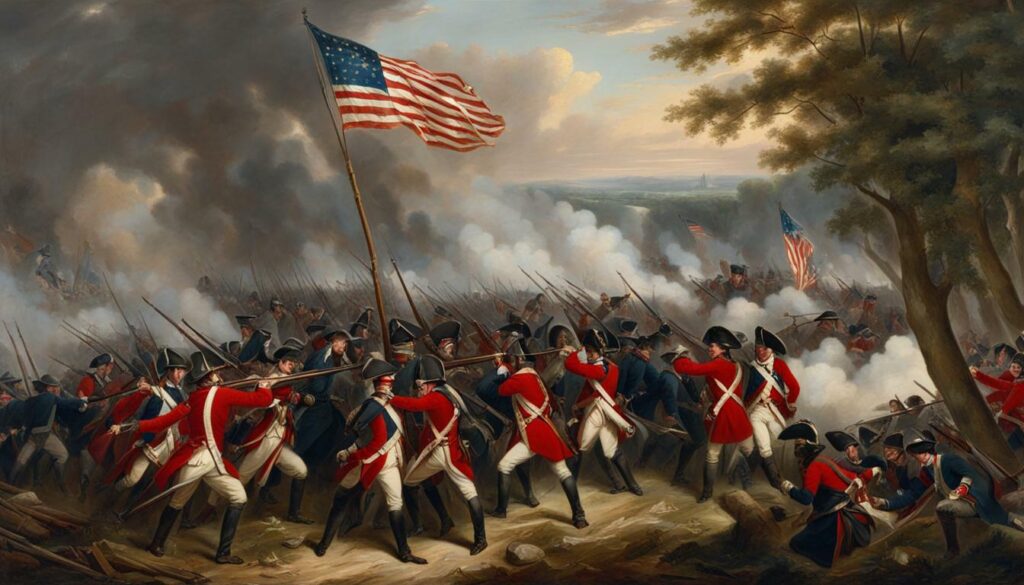
After facing defeats in New York City, George Washington’s Continental Army retreated to the village of White Plains. The retreat was a strategic decision made by Washington in order to regroup and establish a more defensible position against the advancing British forces. The Battle of White Plains, which took place on October 28, 1776, marked a crucial phase in the American Revolutionary War.
Washington’s army sought to buy time and preserve their fighting force by choosing White Plains as their next defensive position. The village offered a natural barrier with hills and high ground, which Washington believed would provide an advantage in the upcoming battle. However, the Continental Army faced significant challenges in their attempt to establish a solid position in White Plains.
“We are now just getting into a new scene of difficulties,” Washington wrote to his cousin Lund Washington on October 30, 1776. This quote reflects the challenges Washington’s army confronted upon their retreat to White Plains. Despite their efforts, they ultimately failed to gain control of the high ground, which proved to be a critical factor in the outcome of the battle.
The British troops, led by General William Howe, launched a relentless assault on Washington’s army, driving them from the hill near the village. With their position compromised, Washington ordered a retreat farther north, further intensifying the challenges and hardships faced by his troops. The Battle of White Plains resulted in a British victory and set the stage for subsequent events in the American Revolutionary War, including the chase of Washington’s army across New Jersey and into Pennsylvania.
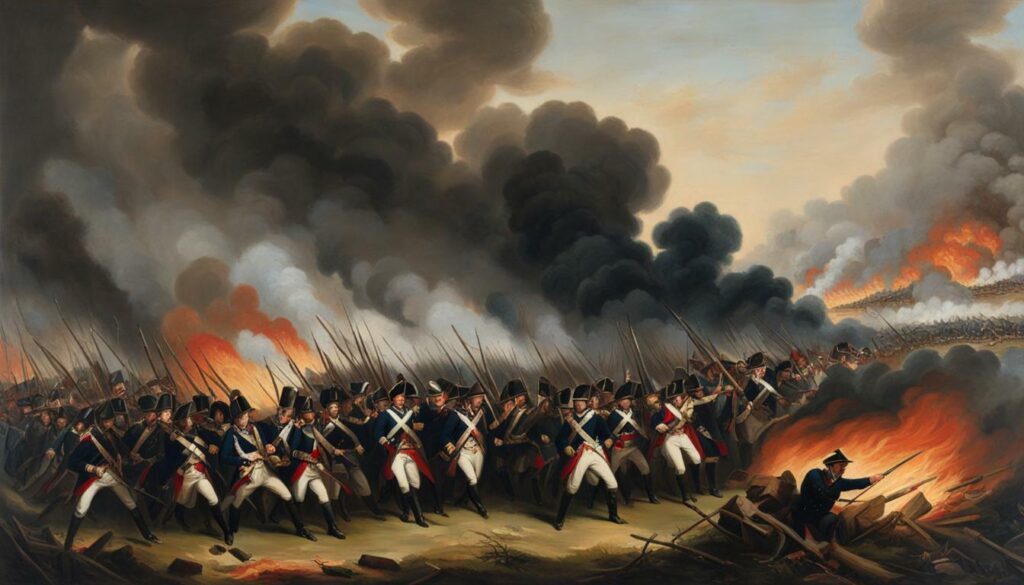
| Battle Details | |
|---|---|
| Date | October 28, 1776 |
| Location | White Plains, New York |
| Belligerents | British Army vs. Continental Army |
| Result | British victory |
| Significance | The Battle of White Plains played a significant role in shaping the course of the American Revolutionary War, leading to further engagements such as the Battle of Trenton. |
Establishing a Position in White Plains
Once in White Plains, Washington’s army fortified their position in preparation for the British advance. The village offered strategic advantages with its hilly terrain and access to major roads, making it an ideal location for Washington to establish a defensive position. The army dug trenches and constructed earthworks to fortify their position, creating a formidable barrier against the approaching British troops.
Despite their efforts to fortify their position, Washington’s army faced numerous challenges. The lack of sufficient troops and resources posed a significant disadvantage. Additionally, the hastily constructed fortifications were not as strong as desired, leaving the army vulnerable to potential British attacks.
The sheer size and strength of the British forces also posed a threat to Washington’s army. British General William Howe strategically positioned his troops and artillery to overlook the American positions. This advantage allowed the British to maintain control of the high ground, rendering Washington’s fortifications less effective.
Table: Fortifications in White Plains
| Fortification Type | Number |
|---|---|
| Trenches | 7 |
| Redoubts | 4 |
| Breastworks | 12 |
Despite the challenges faced by Washington’s army in establishing their position in White Plains, their efforts demonstrated their determination and resourcefulness in the face of a formidable enemy. The upcoming sections will explore the events that unfolded during the Battle of White Plains and the impact it had on the course of the American Revolutionary War.
Failed Attempt to Control the High Ground
The high ground near White Plains played a crucial role in the Battle of White Plains, and Washington’s army was unable to seize it. Positioned on a hill overlooking the village, the high ground offered strategic advantages such as superior visibility and defensive positions. Control of this elevated terrain would have given Washington’s troops a significant edge in the battle, allowing them to rain down artillery fire and effectively repel the British assault.
Despite recognizing the importance of the high ground, Washington’s army faced several obstacles in their attempts to secure it. The terrain was rugged and densely wooded, making it challenging to maneuver troops and artillery. Additionally, time was of the essence, as British forces were rapidly closing in on Washington’s retreating army.
The British troops, led by General Howe, launched a fierce attack on the hill, engaging in intense hand-to-hand combat with Washington’s soldiers. Despite their best efforts, the Continental Army was unable to withstand the British assault and was forced to retreat from the hill, relinquishing control of the high ground.
Table: Battle of White Plains Casualties
| Side | Estimated Casualties |
|---|---|
| Continental Army | Approximately 150-200 killed, wounded, or captured |
| British Army | Approximately 150 killed or wounded |
The failed attempt to control the high ground proved to be a significant turning point in the Battle of White Plains. Without this strategic advantage, Washington’s army was at a severe disadvantage and ultimately had to retreat further north. This setback, however, would not be the end of the Revolutionary War. It paved the way for future Battles, such as the decisive Battle of Trenton, where Washington surprised and defeated Hessian troops, boosting morale and reinvigorating the American cause.
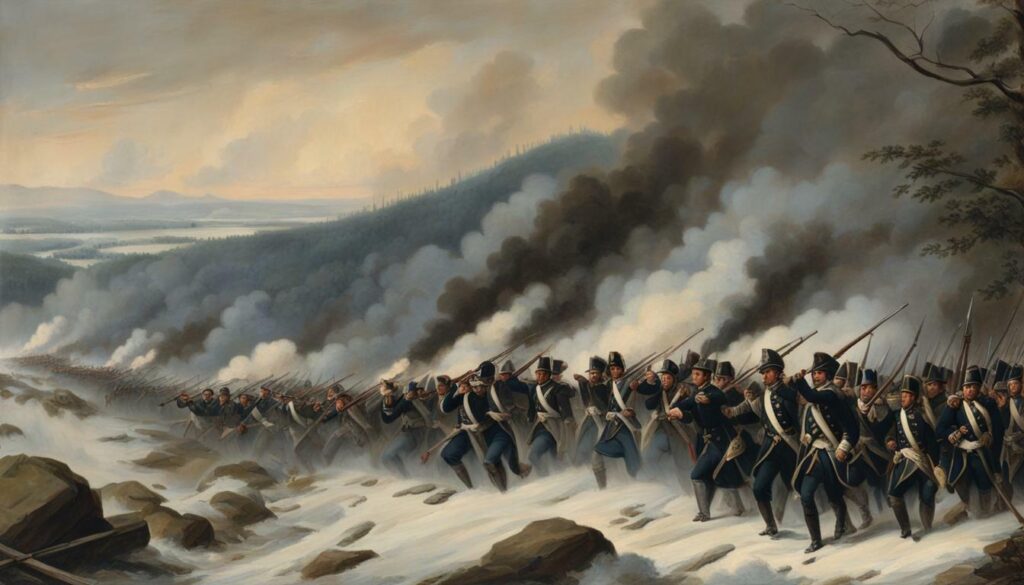
British General William Howe’s troops launched a successful attack on Washington’s army, forcing them to retreat. The Battle of White Plains, fought on October 28, 1776, during the American Revolutionary War, saw Washington’s Continental Army positioned in the village of White Plains after retreating from New York City. However, their strategic disadvantage became evident as they failed to gain control of the high ground.
The British, under Howe’s command, executed a well-coordinated assault on Washington’s troops, driving them from a crucial hill near the village. This defeat forced Washington to order a retreat further north, seeking a more defensible position. The British victory at the Battle of White Plains had significant consequences, leading to a pursuit of Washington’s army across New Jersey and into Pennsylvania.
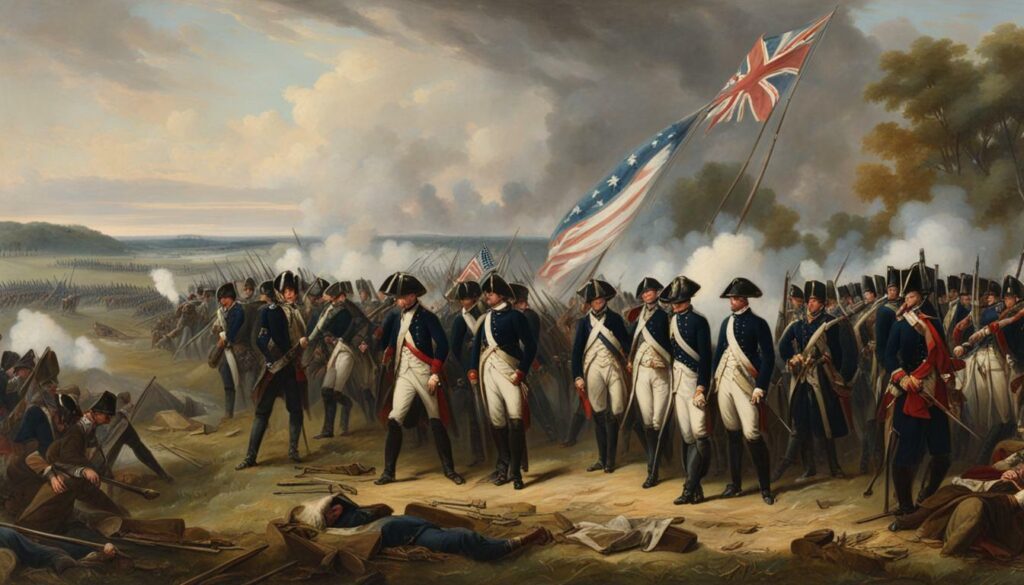
This relentless chase set the stage for the subsequent Battle of Trenton on December 26, where Washington, determined to regain momentum, launched a surprise attack on Hessian troops. The Battle of White Plains showcased the British army’s superior tactics and strategic advantage, while also revealing the resilience and adaptability of Washington’s troops.
| Key Takeaways: |
|---|
| British General William Howe’s troops successfully attacked Washington’s army. |
| Washington’s retreat from White Plains resulted in a pursuit across New Jersey and into Pennsylvania. |
| The Battle of White Plains set the stage for the subsequent Battle of Trenton. |
In summary, the Battle of White Plains marked a significant turning point in the Revolutionary War. It highlighted the challenges faced by Washington’s army and the relentless pursuit they endured. The outcome of the battle led to further strategic decisions, ultimately shaping the course of the American Revolution.
Retreat Further North
In the face of the British advance, Washington ordered a retreat, moving his army farther north. The Battle of White Plains had resulted in a British victory, and Washington’s troops were now in a precarious position. With the enemy closing in, Washington made the strategic decision to regroup and find a more defensible position. The retreat further north was a necessary move to protect his remaining forces and buy time to strategize.
Washington’s army faced numerous challenges as they retreated. The harsh winter weather, dwindling supplies, and constant pursuit by British forces put them under immense pressure. Despite these hardships, Washington remained determined to keep the fight for independence alive. His resilience and leadership would prove crucial in the months to come.
During this period, Washington’s army would go on to face further challenges, including the Battle of Trenton on December 26. It was in this battle that Washington surprised Hessian troops, securing a much-needed victory for the Continental Army. The Battle of White Plains served as a catalyst for these subsequent events, shaping the course of the American Revolutionary War.
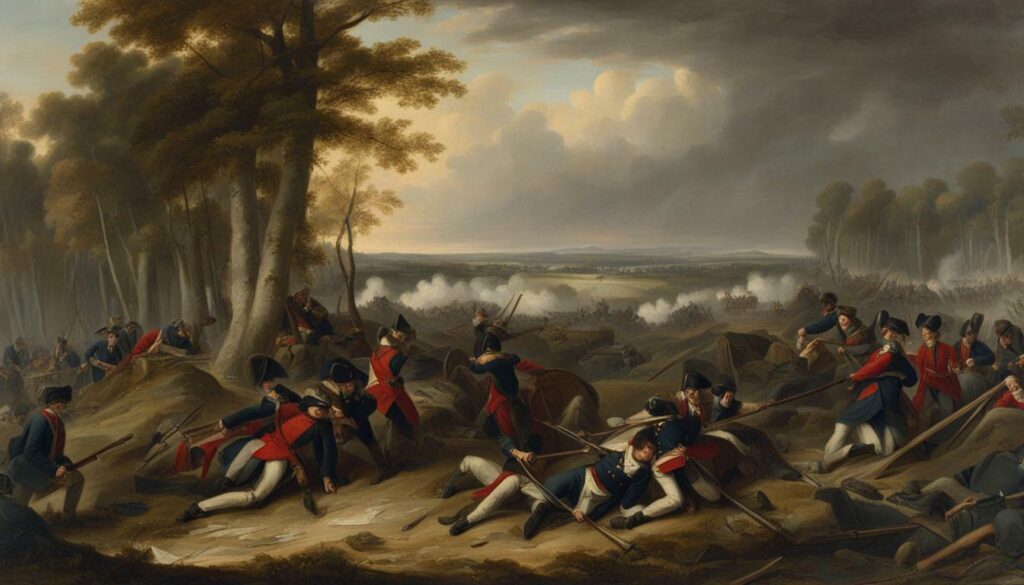
Casualties
| Battle | Date | British Casualties | Continental Army Casualties |
|---|---|---|---|
| Battle of White Plains | October 28, 1776 | Unknown | Unknown |
| Battle of Trenton | December 26, 1776 | Unknown | Unknown |
The exact number of casualties from the Battle of White Plains remains unknown. Historical records have not provided a definitive count of British and Continental Army casualties. Similarly, the casualties from the subsequent Battle of Trenton are also uncertain. However, these battles were undoubtedly costly for both sides, demonstrating the sacrifices made by soldiers on both sides of the conflict.
Chased Across New Jersey and into Pennsylvania
The British victory at White Plains forced Washington’s army to flee, leading to a pursuit that crossed New Jersey and extended into Pennsylvania. With the American forces in disarray and morale low, British General William Howe saw an opportunity to crush the rebellion and pursued Washington’s retreating army.
The pursuit was grueling, with Washington’s troops constantly on the move to avoid capture. The harsh winter weather made conditions even more challenging, as soldiers battled freezing temperatures and limited supplies. Despite these hardships, Washington’s leadership kept the army together and maintained a determined resistance.
The pursuit finally came to a head during the Battle of Trenton on December 26, 1776. Washington, aware of the demoralized and unsuspecting Hessian troops stationed in Trenton, launched a surprise attack, resulting in a decisive American victory. This unexpected win provided a much-needed boost to the morale of Washington’s army and the American cause as a whole.
Table: British Pursuit of Washington’s Army
| Date | Event |
|---|---|
| October 28, 1776 | Battle of White Plains – British victory |
| October – December 1776 | British pursuit of Washington’s army across New Jersey to Pennsylvania |
| December 26, 1776 | Battle of Trenton – American victory |
The Battle of White Plains marked a turning point in the Revolutionary War, as it forced Washington’s army to adapt their strategies and evade the pursuing British forces. This period of retreat and pursuit set the stage for future battles and ultimately shaped the course of the war. Despite the initial defeat, Washington’s resilience and tactical maneuvers would prove pivotal in securing future victories and ultimately achieving American independence.
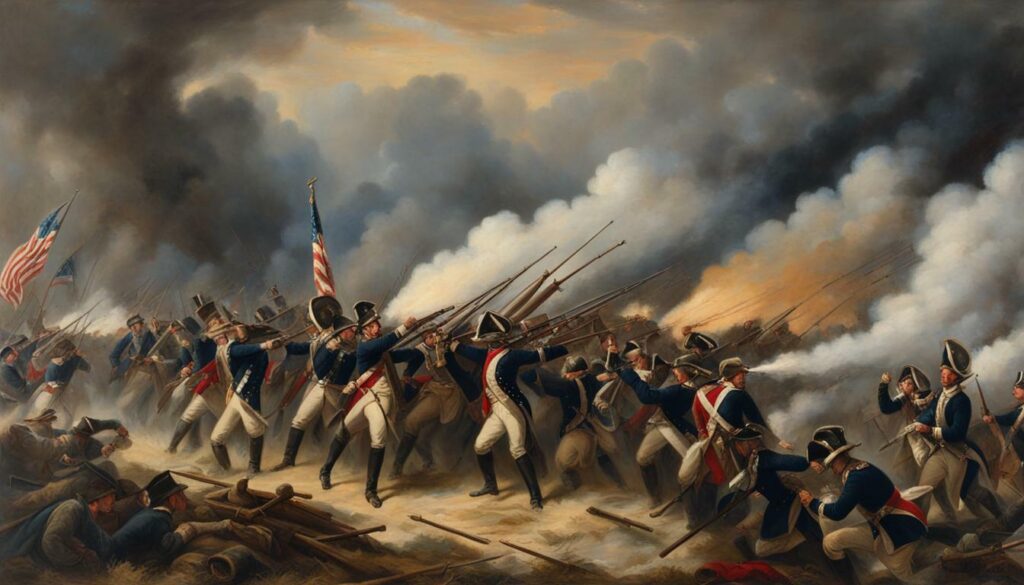
The retreat from White Plains eventually led to the Battle of Trenton, where George Washington planned a surprise attack on Hessian troops. Taking place on December 26, 1776, this pivotal battle followed Washington’s earlier setbacks and served as a much-needed morale booster for the American forces.
Washington, recognizing the need for a victory to boost the spirits of his weary troops and the American revolutionaries, devised a daring plan to cross the icy Delaware River and launch a surprise attack on the Hessian garrison at Trenton, New Jersey. Despite harsh weather conditions and logistical challenges, Washington’s army successfully crossed the river under the cover of darkness.
As dawn broke on December 26, Washington’s forces launched a swift and coordinated attack on the unsuspecting Hessians, who were caught off guard and ill-prepared for the assault. The American troops quickly overwhelmed the Hessian garrison, capturing nearly 900 prisoners and seizing much-needed supplies and ammunition.
The victory at Trenton marked a turning point in the American Revolution, demonstrating Washington’s strategic abilities and boosting the morale of his troops and the American people. This success ultimately inspired more recruits to join the Continental Army and galvanized support for the revolution. The Battle of Trenton served as a catalyst for future victories and highlighted the resilience and determination of the American forces in their fight for independence.
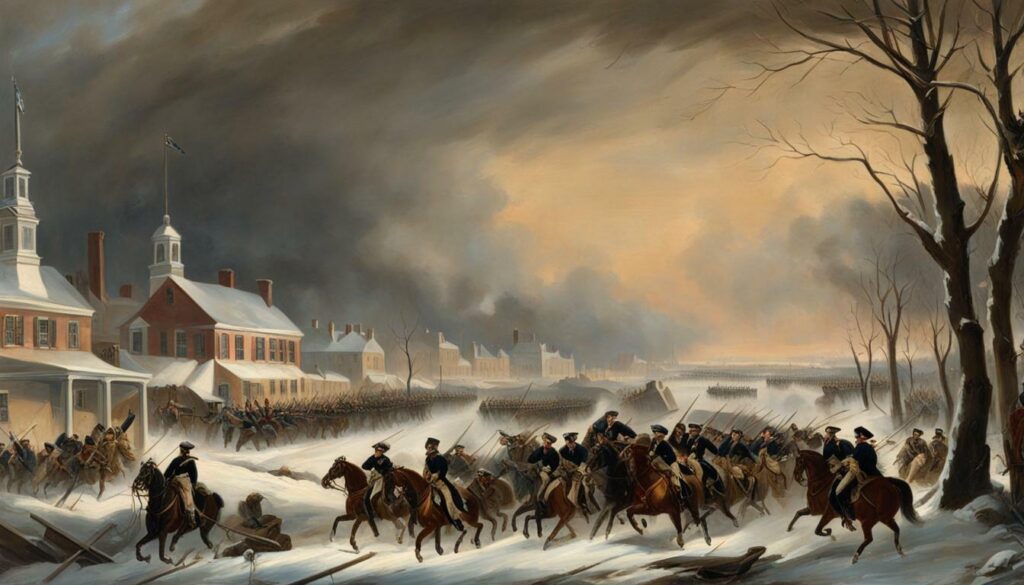
| Key Facts about the Battle of Trenton: | |
|---|---|
| Date: | December 26, 1776 |
| Location: | Trenton, New Jersey |
| Commander: | George Washington |
| Opposing Commander: | Colonel Johann Rall (Hessian) |
| American Casualties: | 2 killed, 5 wounded |
| Hessian Casualties: | 22 killed, 92 wounded, 918 captured |
Quotes:
“We have this day made a glorious stand, and purchased liberty at the expense of a few lives.” – George Washington
- The retreat from White Plains led to the Battle of Trenton, a crucial turning point in the American Revolutionary War.
- Washington’s surprise attack on the Hessian garrison at Trenton demonstrated his strategic prowess and boosted morale among his troops.
- The victory at Trenton inspired more recruits to join the Continental Army and galvanized support for the American revolution.
The Significance of the Battle of White Plains
The Battle of White Plains had a significant impact on the Revolutionary War, shaping the subsequent events of the conflict. Occurring on October 28, 1776, it marked a turning point in the war as General George Washington’s Continental Army faced off against the British troops led by General William Howe.
Despite Washington’s army ultimately suffering a defeat, the battle demonstrated the resilience and determination of the American forces. It highlighted Washington’s strategic thinking in establishing a defensive position in White Plains, utilizing the terrain to his advantage.
The battle also revealed the importance of controlling the high ground. Washington’s failure to secure this advantageous position allowed Howe’s troops to gain a tactical advantage and ultimately drive the Continental Army from the hill near the village. This loss forced Washington to order a retreat, leading to a series of subsequent events that shaped the course of the war.
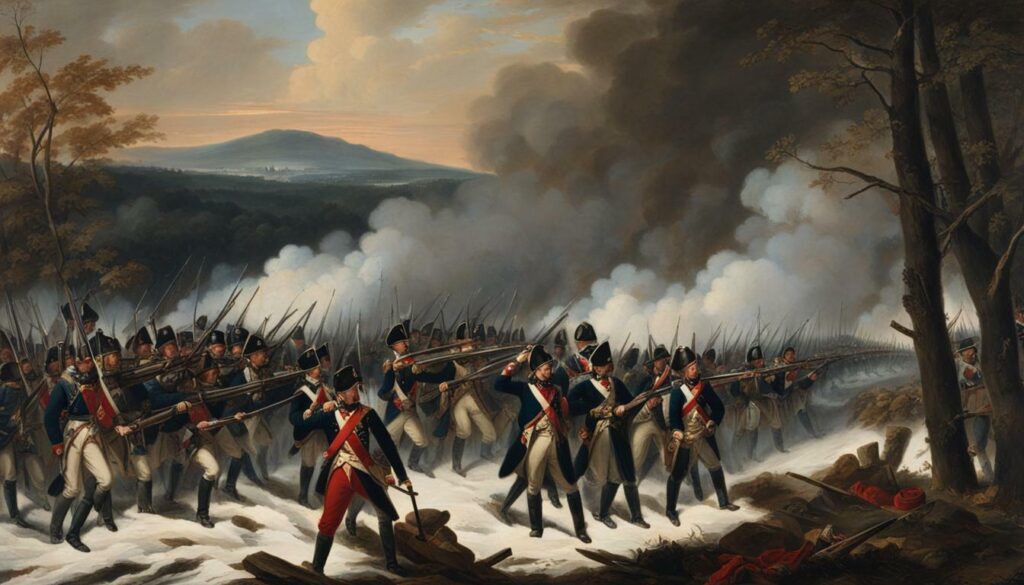
The significance of the Battle of White Plains can be seen in its impact on the broader war effort. The retreat from White Plains led Washington’s army to regroup and rethink their strategy, eventually culminating in the pivotal Battle of Trenton. This surprise attack on December 26, 1776, allowed Washington to regain momentum and serve as a symbol of hope for the struggling American Revolution.
In conclusion, the Battle of White Plains played a significant role in shaping the Revolutionary War. It showcased the determination of Washington’s army, highlighted the importance of strategic positioning, and set the stage for subsequent events that would ultimately lead to American independence.
Conclusion
The Battle of White Plains was a key moment in the American Revolutionary War, marking a turning point in the conflict. Fought on October 28, 1776, this battle showcased the resilience and determination of George Washington’s Continental Army in their fight for independence against the British forces.
After retreating from New York City, Washington’s army established their position in the village of White Plains. However, their failure to gain control of the high ground proved to be a strategic disadvantage. British General William Howe and his troops drove Washington’s forces from a hill near the village, forcing Washington to order a retreat.
This retreat marked a significant setback for Washington and his army, as they were pursued across New Jersey and into Pennsylvania by the British. However, it also set the stage for the subsequent Battle of Trenton on December 26, where Washington would surprise and defeat Hessian troops, boosting morale and revitalizing the American cause.
The Battle of White Plains, though ultimately a British victory, played a crucial role in shaping the course of the American Revolutionary War. It highlighted the challenges faced by Washington’s army and the need for strategic maneuvering. This battle, along with the events that followed, demonstrated the determination and resilience of the American forces as they fought for their independence.
FAQ
Q: When was the Battle of White Plains fought?
A: The Battle of White Plains was fought on October 28, 1776.
Q: What was the outcome of the Battle of White Plains?
A: The battle resulted in a British victory.
Q: What was the significance of the Battle of White Plains?
A: The Battle of White Plains marked a turning point in the American Revolutionary War, as George Washington’s army was forced to retreat, leading to a series of subsequent battles.
Q: Who were the key commanders in the Battle of White Plains?
A: The key commanders were George Washington for the Continental Army and William Howe for the British Army.
Q: How did the battle impact the war effort?
A: The defeat at the Battle of White Plains led to Washington’s army being chased across New Jersey and into Pennsylvania, eventually resulting in the Battle of Trenton where Washington surprised Hessian troops.
Q: What was the location of the Battle of White Plains?
A: The battle took place in the village of White Plains in New York.
Q: How did Washington’s army establish a position in White Plains?
A: After retreating from New York City, Washington’s army established a position in White Plains to regroup and strategize.
Q: Did Washington’s army gain control of the high ground?
A: No, Washington’s army failed to gain control of the high ground, which had a significant impact on the outcome of the battle.
Q: What happened after Washington’s army was driven from the hill near the village?
A: Washington ordered a retreat further north following the defeat at White Plains.
Q: How did the Battle of White Plains connect to the Battle of Trenton?
A: The Battle of White Plains led to Washington’s retreat, which eventually led to the Battle of Trenton where Washington surprised Hessian troops.
Q: Was the Battle of White Plains a major battle in the American Revolutionary War?
A: While not as well-known as other battles, the Battle of White Plains played a significant role in the overall scope of the Revolutionary War.

